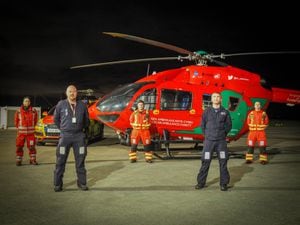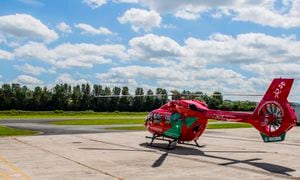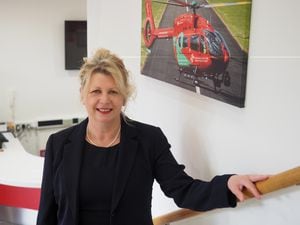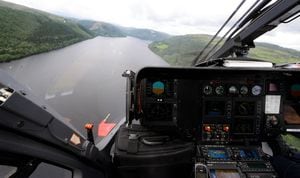Wales Air Ambulance looks back on its 'incredible evolution' as charity celebrates 20th anniversary
A lifesaving medical service which turns 20 today has taken a look back at its incredible evolution and is paying tribute to everybody who has contributed to keep it running.

Wales Air Ambulance Charity, which has undertaken nearly 38,000 missions, is marking the special anniversary.
It comes as the Midlands Air Ambulance is also celebrating a 30 year milestone this year – and the pandemic has proved a challenging time for both charities, which must raise millions of pounds each year to keep running.
The late Robert Palmer was the founder and first chair of trustees of the service in Wales.
From his vision, the charity has grown from a one-helicopter operation based at Swansea Airport to what is now the largest air ambulance operation in the UK, with four helicopters.
Its aircraft are based across the country, in Caernarfon, Welshpool, Llanelli and Cardiff.

Dave Gilbert, the charity’s chair of trustees, said: “Looking back and following the timeline of how Wales Air Ambulance has evolved over the last 20 years gives everyone a huge sense of pride.
"From Robert Palmer’s early vision through to becoming one of the largest and medically advanced operations is an achievement that the whole of Wales can be proud of.
"After all, Wales Air Ambulance was created by the people of Wales, for the people of Wales, and the growth of our charity is testament to the skill, dedication, passion and generosity that exists within our country.”
In the past two decades, it has evolved from a paramedic-led service to a consultant-led service which takes the emergency department to the patient.
Thanks to the charity’s unique partnership with the Emergency Medical Retrieval and Transfer Service and NHS Wales, it is one of the most medically advanced air ambulance operations in Europe.
When the service first started in 2001, it ran eight hours a day, five days a week, and its vision was to become 24/7.
That was achieved in December last year, with the introduction of an overnight helicopter in addition to the 12-hour day-time cover.
To keep the helicopters in the air 24/7, it needs to raise £8 million every year.
Dr Sue Barnes, the charity’s chief executive said: “I took up my post with the Wales Air Ambulance last December and it quickly became clear why the charity has thrived over the past 20 years through the professionalism, enthusiasm and commitment of those involved.

"This has allowed us to deliver a lifesaving service which has positively impacted many lives across the country.
“Everybody who has contributed to our charity over the years can be proud of their contribution as they have played their part in making the charity what it is today.
"We would like to say a heartfelt thanks to the medics, pilots, critical care allocators, staff and volunteers, trustees, and all those who have fundraised and donated over the last 20 years.”
The first patient to be airlifted by Wales Air Ambulance was Neil Chattington.
Twenty years ago, he started an under 16s rugby match and little did he know that he would become a significant part of the charity's history.
Reflecting on his memories on the day, Neil, who was playing for Glynneath Rugby Club against Aberavon, said: “I remember quite a bit. It had snowed a little overnight and we cleared the ground before starting.
"Aberavon had a really good team with a couple of players who went on to do good things. We always had tough games with them.
“At the time of the incident, we were attacking from our half and I'd made a break, getting past their fullback into open space – or what I thought was open space – and got tackled very hard by one of their props.

"I wasn't expecting to be tackled so wasn't tensed for it. I got spun around and hit the ground hard and when I settled, I felt a really sharp pain in the left side of my neck and lost the feeling in my arms and legs.
“Initially I was really panicked but I didn't try to move and quickly the referee stopped the game.
"When the first aiders knew what was wrong, the ambulance was called and I was well looked after by both teams, first aiders and some parents, one who used a horse blanket to keep me warm.”
The Wales Air Ambulance crew that day were paramedics Mark Winter and Paul Haddow, and pilot Steve Rush.
Mr Winter still works with the service today as its operations director.
The crew were sent to the rugby club for its first mission by Brian Knoyle, who worked for the ambulance service control, after it was feared Neil had a broken back.
Neil, who has lived in Cardiff for 14 years, said seeing the helicopter land ‘initially made him feel quite scared’ due to the fact he’s afraid of flying, but he had ‘confidence in the crew’.

He added: “My first thought was ‘oh dear’, and definitely ‘something’s wrong’. Having had my fair share of bumps, I knew that this was different.
"The flight was surprisingly quick and not quite as scary as I thought it would be. I was constantly monitored throughout the flight.
"Looking back, I think about how simple it was and that it could have been so much worse.”
Neil, who runs his own property maintenance company, was airlifted from Glynneath Rugby Club to Morriston Hospital.
Wales Air Ambulance Charity will mark its 20th anniversary with a year-long series of activities and events starting today – kicking off with its ‘My20’ fundraising challenge.
Visit www.walesairambulance.com/my20 to find out how you can get involved.
